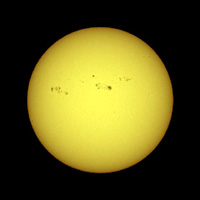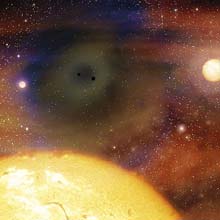Physics and Astronomy
This area deals with the fundamental laws and building blocks of nature and how they interact, the properties and the behavior of matter, and research into space and time and their structures.
innovations-report provides in-depth reports and articles on subjects such as astrophysics, laser technologies, nuclear, quantum, particle and solid-state physics, nanotechnologies, planetary research and findings (Mars, Venus) and developments related to the Hubble Telescope.

A First Look at the Doughnut Around a Giant Black Hole
First detection by infrared interferometry of an extragalactic object
Active galactic nuclei (AGN) are one of the most energetic and mysterious phenomena in the universe. In some galaxies indeed, the core generates amounts of energy which surpass those of normal galaxies, such as the Milky Way, by many orders of magnitude.
The central engine of these power stations is thought to be a supermassive black hole. Indirect lines of evidence have suggested that these massive black

Powerful ’conveyor belts’ drive Sun’s 11-year cycle, new evidence suggests
NASA and university astronomers have found evidence the 11-year sunspot cycle is driven in part by a giant conveyor belt-like, circulating current within the Sun.
The astronomers, Dr. David Hathaway, Robert Wilson and Ed Reichmann of NASA’s Marshall Space Flight Center in Huntsville, Ala., and Dr. Dibyendu Nandy of Montana State University in Bozeman, reported their findings the week of June 16 at the annual meeting of the Solar Physics Division of the American Astronomical Soci

The universe just became a little simpler
Using images from the Hubble Space Telescope, astronomers have concluded that two of the most common types of galaxies in the universe are in reality different versions of the same thing. In spite of their similar-sounding names, astronomers had long considered “dwarf elliptical” and “giant elliptical” galaxies to be distinct objects. The new findings, which appear in this month’s edition of The Astronomical Journal, fundamentally alter astronomers’ understanding of these important components of th

First Mars, then Venus!
Fifteen days after the launch of Mars Express, Europe has reaffirmed its trust in Soyuz: next stop Venus in 2005!
Just two weeks after the flawless launch of Mars Express on its way towards the Red Planet, ESA and the European-Russian company Starsem reinforced their relationship with the signature of the Venus Express launch services agreement.
The contract was signed at Le Bourget (Paris) Air Show, Tuesday, 17 June 2003, by David Southwood, Director of Science for the European Sp

Scientists may have succeeded in reproducing matter as it first appeared after the Big Bang
Multi-National team of physicists include Weizmann Institute Scientists
Recent results of a joint experiment conducted by 460 physicists from 57 research institutions in 12 countries strongly indicate that the scientists have succeeded in reproducing matter as it first appeared in the universe; this matter is called the quark-gluon plasma. The experiment, called PHENIX and conducted at the Brookhaven National Laboratory on Long Island, New York, has brought together physicists from Br

ESA’s XMM-Newton makes the first measurement of a dead star’s magnetism
Using the superior sensitivity of ESA’s X-ray observatory, XMM-Newton, a team of European astronomers has made the first direct measurement of a neutron star’s magnetic field.
The results provide deep insights into the extreme physics of neutron stars and reveal a new mystery yet to be solved about the end of this star’s life.
A neutron star is very dense celestial object that usually has something like the mass of our Sun packed into a tiny sphere only 20–30 km across. It is the p